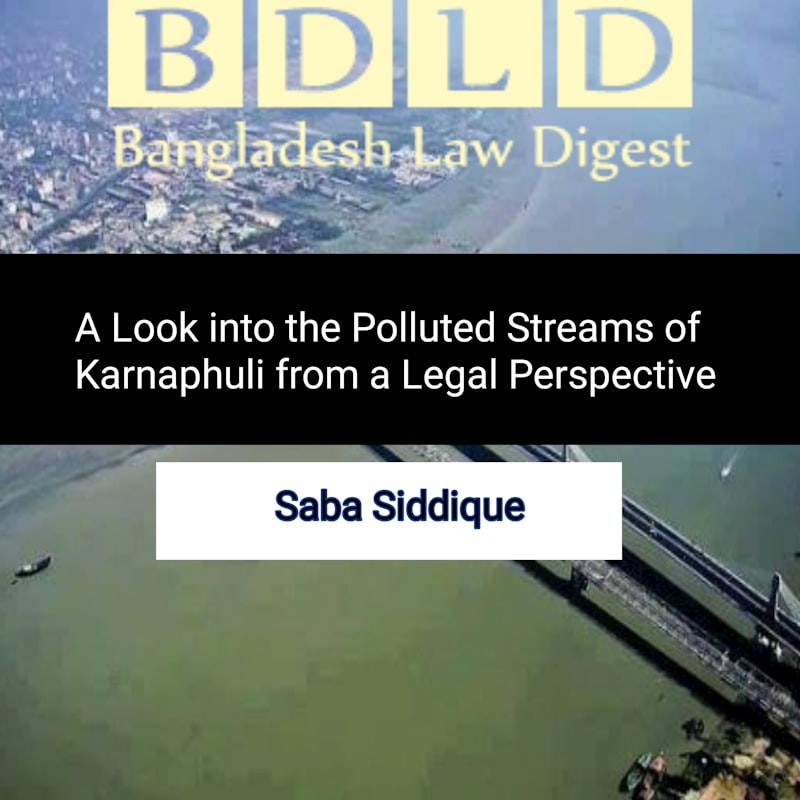Introduction
More than 78 years ago, the Trail Smelter Tribunal heralded a new era in the field of International Environmental Law, establishing the principle of Trans-boundary Harm.[1] It formulated the concept of Trans-boundary Harm in a period where any kind of authority over this notion regarding air pollution was non-existent in the arena of international law.[2]
In a nutshell, the facts of the case are as such: fumes from the smelter at Trail, Columbia in Canada were found to be causing damage in Washington, USA. The states then had to take recourse to the Tribunal in the absence of a proper forum. The tribunal based its decision upon two principles in resolving the dispute, namely,
(1) ‘Transboundary Harm’, i.e. imposing a duty upon a state to prevent harm to the boundary of another state which emanates from the territory of former; and,
(2) ‘Polluter Pays’ which holds that the polluting state should pay compensation for the Trans-boundary harm caused. By embodying the Latin maxim “sic utere tuo ut alilenum non laedas” in formulating the trans-boundary harm concept, the tribunal held, in essence, that Canada was required to ascertain that the smelter would refrain from causing damage in the state of Washington.[3]
Precisely, the intent of this discussion is to briefly cast a bird’s eye view over the inception and nature of the influence of the doctrine of transboundary harm in the arena of international environmental Law.
Obstacles Faced
The inception of this journey run by the Trail Smelter Tribunal was somewhat problematic. It was due to the fact that there was a decisional vacuum from international tribunals to resolve the issues brought before it. Therefore, the tribunal had to strike a balanced solution; one that neither shuts down the smelter nor undermines the agricultural interest of Washington, USA.[4]
This implicit condition was to be maintained otherwise, it would incur the classic problem of “clash of sovereignties”: the sovereign right of Canada to do as it pleased in its own territory versus the sovereign right of USA to be free from outside interference in its territory.[5] Hence, the Tribunal fashioned a solution that “would allow the continuance of operation of Trail Smelter under such limitations and restrictions as would, as far as foreseeable, prevent damage in the United States, and as would enable the indemnity to be obtained, if in spite of such limitations and restrictions, damage should occur in the future in the United States.”[6]
For the purpose of striking this balance, which became compatible with the states, the tribunal constructed ‘Transboundary Harm’ rule, which is as follows:
“[U]nder principles of international law, as well as of the law of the United States, no State has the right to use or permit the use of its territory in such a manner as to cause injury by fumes in or to the territory of another or the properties or persons therein, when the case is of serious consequence and the injury is established by clear and convincing evidence.”[7]
This governing principle of the tribunal’s decision seems to have influenced international legal instruments and juristic thoughts, which can be observed from the wide array of the progeny of Trail Smelter Arbitration produced considerably over the years. These progenies can be categorized by two streams, namely – the political stream and the expert and judicial stream.
The political stream tends to juxtapose a quite liberalized formulation of the strict rule pronounced by the tribunal, as evident from the wordings – ‘serious consequence’ and ‘clear and convincing evidence’ in its statement. It also reaffirms the sovereignty of the states which the tribunal had to confront and avoid in the resolution of the dispute. The classic resonance of political stream can be detected in Principle 21 of the 1972 Stockholm Declaration on the Human Environment.
The Principle reads:
“States have, in accordance with the Charter of the United Nations and the principles of international law, the sovereign right to exploit their own resources pursuant to their own environmental policies, and the responsibility to ensure that activities within their jurisdiction or control do not cause damage to the environment of other States or of areas beyond the limits of national jurisdiction”.
One aspect of this principle is found to have shown a liberal formulation of the earlier rule proclaimed by the tribunal in Trail Smelter Arbitration. In Principle 21 of the 1972 Stockholm Declaration on the Human Environment, with reasserted ‘sovereignty’, ‘no environmental damage’ elements are catered side by side.
This aspect distinguishes Principle 21 from the statement by the tribunal as the latter had to have the utmost regard to the infallible concept of ‘sovereignty’ which moved the tribunal to qualify the damage by declaring the statement mentioned above[8].
An interesting point to be noted is that there is no qualification on the concept of ‘damage’, which is supposedly left out for the concerned states to work on. This was not the same in the principle constructed by the Trail Smelter tribunal as it qualified ‘damage/injury’ to be established by clear and convincing evidence. Thus, it may be observed that Principle 21 of the 1972 Stockholm Declaration widened its notion of ‘damage’ and evolved to some extent from the rule of Trail Smelter arbitration.
Traces of this concept of transboundary harm having a liberal and wide concept of damage, and positioning state sovereignty side by side, can be detected in numerous international legal instruments. It was found to have been exhibited in Principle 2 of the Rio Declaration, Article 3 of the Convention on Biological Diversity and Principle 1(a) of the Statement of Forest Principles.
Finally, both the United Nations Convention to Combat Desertification and the United Nations Framework Convention on Climate Change reproduce Principle 2 of the Rio Declaration verbatim in their preambles. All of these texts negotiated and adopted this liberal concept while defining ‘damage’.
Influence on Legal and Juristic Thoughts
The political constraints that made these aforementioned instruments to have ‘sovereignty’ element within the conception of ‘Transboundary Harm’ for attaching responsibility were not welcomed by the International Court of Justice (ICJ). The Court was free to detach obligation from any mention of sovereignty. In its “Advisory Opinion in Legality of the Threat or Use of Nuclear Weapons”[9] and later on, in its judgment in the case concerning the ‘Gabˇc´ıkovo-Nagymaros’ Project, the Court stated:
“The existence of the general obligation of States to ensure that activities within their jurisdiction and control respect the environment of other States or of areas beyond national control is now part of the corpus of international law relating to the environment.”[10]
This approach of the detachment of obligation and posing it as a general obligation of states may be observed as a bold step since ‘sovereignty’ was once held in high regard in several international instruments. It is further exhibited and exemplified in the Corfu Channel case[11], the International Law Commission’s (ILC) several drafts, referred to it by General Assembly, namely, the 1958 Geneva Conventions on the Law of the Sea[12]; the Vienna Convention on Diplomatic and Consular Relations; and the Vienna Convention on the Law of Treaties.
Another example pertaining to the “expert and judicial” stream is the final Report of the Brundtland Commission’s Experts Group on Environmental Law, published in 1987 in conjunction with the report of the Brundtland Commission itself. It resonates with this stream in its Article 10.[13]
Lastly, although compensation in case of transboundary harm is now an established norm in the arena of international law, a standard method of calculating the compensation could not be found by the ICJ till 2018. However, on February 2 2018, the ICJ tried to resolve this issue to some extent in the Costa Rica v. Nicaragua case[14], which made an opening to find a more advanced and standard way of calculating compensation. Here, the learned judges not only put forward some of their own thoughts and views on how to polish and refine the methods of calculation but also added contemporary dimensions of international environmental law on the subject matter.
Conclusion
The decision of the Trail Smelter Arbitration, made 78 years ago has profoundly influenced and is still invoked as authoritative text international environmental law literature, marking the evidence of its relevance even today.
International environment law on transboundary harm is still a growing jurisprudence since many questions can be brought up regarding the extent to which it would be convenient and a dispute resolution-friendly approach to compromise a state’s right to exploit its own resources. Whether the implicit policy of the International Court of Justice to detach the obligation or liability for transboundary harm from the consideration of a state’s ‘sovereign’ status is a suitable way to deal with this kind of matters is an area for legal scholars and jurists to work on and further its development.
━━┅━━━┅━━
Copyright: Any unauthorized use or reproduction of Bangladesh Law Digest (BDLD) content for commercial purposes is strictly prohibited and constitutes copyright infringement liable to legal action.
[1] Trail Smelter Arbitral Decision, 35 American journal of International Law 684 (1941) [hereinafter “Trail Smelter (1941)”]
[2] Trail Smelter (1941), supra note 1, at 684.
[3] Trail Smelter (1941), supra note 1, at 716–17. See Alexandre Kiss and Dinah Shelton, International
Environmental Law 107 (1991)
[4] James F. Jacobson, ‘Through the Looking Glass: Sustainable Development and Other Emerging Concepts of International Environmental Law in the Gabˇcikovo-Nagymaros Case and the Trail Smelter Arbitration’ in Rebecca M. Bratspies and Russell A. Miller (eds), Transboundary Harm in International Law (Cambridge University Press 2006)
[5] See G¨ unther Handl, Territorial Sovereignty and the Problem of Transnational Pollution, 69 American
Journal of International law 50 (1975)
[6] Trail Smelter (1941), supra note 1, at 685
[7] Trail Smelter (1941), supra note 1, at 716
[8] Id
[9] Nuclear Weapons, 1996 I.C.J. 226, at 241–42, para. 29 (July 1996).
[10] Gabˇc´ıkovo-Nagymaros Project (Hun./Slov.), 1997 I.C.J. 7, at 41, para. 53 (Sept. 25).
[11] Corfu Channel (U.K. v. Albania), 1949 I.C.J. 4 (April 1949).
[12] United Nations Convention on the Law of the Sea, 10 Dec. 1982, art. 193 ,U.N. Doc. A/CONF/62/122, reprinted in 21 International Legal Materials 1261 (1983).
[13] Brundtland Commission, Environmental Protection and Sustainable Development (1987).
[14] ICJ, Judgment of 2 February 2018 https://www.icj-cij.org/files/case-related/150/150-20180202-JUD-01-00-EN.pdf accessed 19 May 2019














